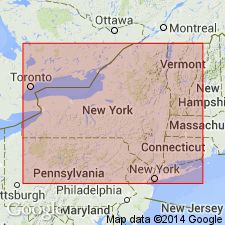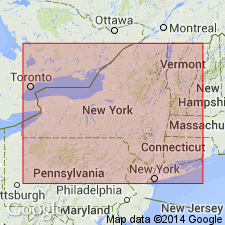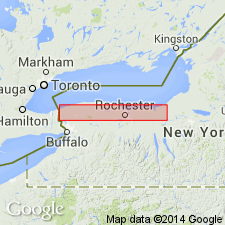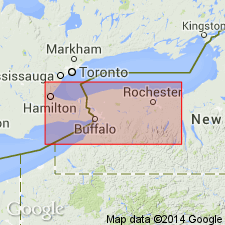
- Usage in publication:
-
- Cambria Shale Member
- Modifications:
-
- First used
- Dominant lithology:
-
- Shale
- AAPG geologic province:
-
- Appalachian basin
Summary:
The upper part of the Thorold Formation of the Medina Group is referred to here informally as the Cambria Member for the exposure along Lockport Junction Road on the eastern townline of Cambria, NY. Shale is capped by the Kodak Formation. Unit is described as a 2-3-m thick red and green shale with abundant leperditian ostracodes. Age is Early Silurian (Alexandrian).
Source: GNU records (USGS DDS-6; Reston GNULEX).

- Usage in publication:
-
- Cambria Formation
- Modifications:
-
- Revised
- AAPG geologic province:
-
- Appalachian basin
Summary:
The Medina Group comprises 11 facies, which can be organized into three facies associations. The previously defined color-based formations do not conform with lithic correlations except for the Whirlpool and Manitoulin. A formal major revision is being proposed by Brett and others (in press) and Duke and others (in press). The newly revised Medina Group will include the Whirlpool Sandstone at its base (virtually unchanged), the overlying Jolley Cut Formation (a tentative renaming of the Manitoulin), the Balls Falls Formation (new), the Art Park Phosphate Beds (new), the Devils Hole Formation (new), the Grimsby Formation (revised), the Power Glen Formation (revised), the Thorold Formation (revised), the Cambria Formation (new), and the Kodak Formation (resurrected). The Medina unconformably overlies Queenston Shale; unconformably underlies Clinton Group.
Source: GNU records (USGS DDS-6; Reston GNULEX).

- Usage in publication:
-
- Cambria Shale
- Modifications:
-
- Overview
- AAPG geologic province:
-
- Appalachian basin
Summary:
Thorold Sandstone should not be included as the basal unit of the Clinton Group, as the Thorold is found below the basal Clinton unconformity westward from Niagara Co., NY, to St. Catharines, Ontario. Eastward from Niagara Co., the units overlying the Thorold and underlying the Clinton include the 2.0- to 3.0-m-thick reddish, ostracode-bearing Cambria Shale and the 2.0- to 5.0-m-thick greenish to slightly reddish gray Kodak Sandstone. Where the Kodak is absent in Orleans and Niagara Cos., the Cambria directly underlies the Densmore Creek Bed (new) at the base of the Neahga and Maplewood Shales of the Clinton Group. The Thorold, Cambria, and Kodak are conformable with one another and therefore are included in the uppermost Medina Group.
Source: GNU records (USGS DDS-6; Reston GNULEX).

- Usage in publication:
-
- Cambria Shale*
- Modifications:
-
- Named
- Dominant lithology:
-
- Shale
- Siltstone
- Sandstone
- AAPG geologic province:
-
- Appalachian basin
Summary:
Named the Cambria Shale of the Medina Group for Cambria, Niagara Co., western NY. Unit was formerly the upper part of the Thorold Sandstone. Consists of red to reddish-green, sparsely fossiliferous, interbedded shale, siltstone, and fine-grained sandstone. Can be divided into a lower and upper shale separated by a middle sandstone interval. The upper and lower shales contain abundant ostracodes and bivalves. The middle sandstone interval consists of mottled red and green, bioturbated, argillaceous sandstone with thin shale interbeds. Thickness ranges from a feather edge in the north end of the Niagara River gorge to as much as 13.5 ft at Webster, Monroe Co., NY. Unit is also well exposed at railroad overpass on Niagara Street, Lockport, Niagara Co., NY. Overlies the Thorold Sandstone with a sharp contact. Underlies various units due to a regional low-angle unconformity at the top of the Medina Group. Between Rochester and Lockport, NY, it conformably underlies the Kodak Sandstone of the Medina Group; west of Lockport, it unconformably underlies the Neahga Shale of the Clinton Group. The Cambria is of Early Silurian (Llandoverian) age based on stratigraphic position. [Report uses Early and Late Silurian time scale of Harland (1982).]
Source: GNU records (USGS DDS-6; Reston GNULEX).
For more information, please contact Nancy Stamm, Geologic Names Committee Secretary.
Asterisk (*) indicates published by U.S. Geological Survey authors.
"No current usage" (†) implies that a name has been abandoned or has fallen into disuse. Former usage and, if known, replacement name given in parentheses ( ).
Slash (/) indicates name conflicts with nomenclatural guidelines (CSN, 1933; ACSN, 1961, 1970; NACSN, 1983, 2005, 2021). May be explained within brackets ([ ]).

